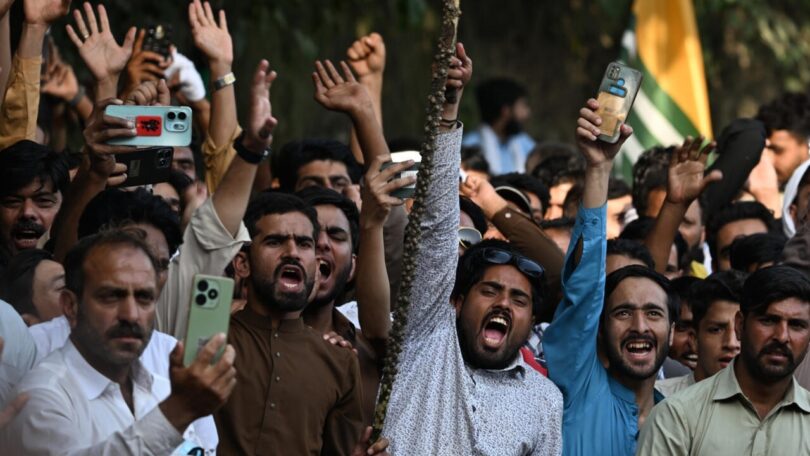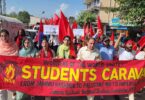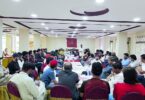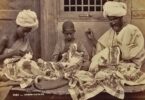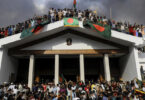By QamarUz Zaman Khan
From 29 September 2025, a new phase of the People’s Rights Movement began in Pakistan-administered Jammu Kashmir — a continuation in essence of the previous stage. The 2023 movement had achieved success in its two major demands: a subsidy on wheat flour and fixing the electricity tariff between three and six rupees per unit. Considering the prevailing electricity rates in Pakistan, obtaining power at three rupees per unit was an extraordinary achievement. In fact, even by international standards, the movement succeeded in winning remarkable gains compared to other contemporary movements around the world.
However, other demands of the Central Joint Awami Action Committee, which had been leading the movement, remained unresolved despite negotiations.
In this background, the new phase of the movement emerged in September 2025. All the objective material conditions that give rise to and advance a mass uprising were present. Yet, the provocative statements by ministers of the Kashmir government and the threats issued by former and current prime ministers added fuel to the fire. Underhand tactics were used to suppress the movement, but instead, public enthusiasm and determination only grew stronger. While negotiations were taking place on one side, over 500 Kashmiri citizens were placed on the Exit Control List (ECL) on the other.
After deadlock persisted on certain points, threatening remarks by Pakistan’s federal representative Tariq Fazal Chaudhry and others further worsened the situation. Meanwhile, mobile and internet services were shut down throughout this part of Jammu Kashmir, and hundreds of active political workers were arrested. This repression inflamed public anger, paving the way for a long march toward Muzaffarabad from Poonch and other regions of Pakistan-administrated Kashmir.
The deployment of 2,000 police personnel and a large contingent of Rangers from Islamabad, as well as attacks by state operatives and their sponsored Muslim Conference thugs, marked the beginning of state violence. Videos circulated on social media showing Sardar Atiq’s (Muslim Conference) men firing openly. Most rallies organized by the Awami Action Committee remained peaceful, but the situation changed dramatically on 29 September, when a young man was killed by police firing at Neelum Bridge.
That was the moment when public fury intensified against state repression. The police contingents sent from Islamabad behaved harshly and aggressively. Later, Kashmir’s Prime Minister Chaudhry Anwar-ul-Haq and Federal Minister Tariq Fazal Chaudhry held a press conference stating that “violence achieves nothing; issues must be resolved through dialogue.” By then, however, it was too late.
According to a local political leader from Bagh, at Chamyati, near Tehsil Dhirkot, unprovoked firing by the forces killed at least three activists and three policemen, while over 150 were injured. This loss of life became a turning point in the movement. In the delayed negotiations that followed, the government was represented by leaders from the PML-N and PPP — figures rejected not only by the people of Kashmir but also by Pakistan’s own public. Many representatives of the popular leadership were excluded from the talks. Consequently, a weak, imbalanced, and vague agreement emerged, with several points deferred for “future consultation.”
Surprisingly, the first clause of the agreement itself legitimized state violence, stating that cases related to violent incidents would be registered under anti-terrorism laws, even if the violence had been perpetrated by state officials. Would the state ever acknowledge its own crimes? The answer lies partly in the alleged audio recordings circulating on social media and WhatsApp groups, in which authorities can be heard speaking of “racial profiling”.
This is the moment to ask: What has this movement lost and what has it gained? Even if all the demands had been met, would the problems of the Kashmiri people be over? The issue of Jammu Kashmir is not merely about flour or electricity tariffs — though those are important concerns — it is about the historic bondage and structural subjugation of this region.
Historical Context
In 1947, at the time of the partition of the Indian subcontinent, Jammu Kashmir was among those unfortunate regions where the decision of accession was imposed by force rather than by the will of the people. Under the British colonial system, Jammu Kashmir was a princely state, and the popular uprising against the Maharaja’s autocratic rule was seen by both newly formed states — India and Pakistan — as an opportunity for intervention and occupation.
Under the pretext of supporting this rebellion, Pakistan sent tribal invaders into Jammu Kashmir, while India, using the plea of assistance, coerced the Maharaja into signing the Instrument of Accession — something he had already been preparing for in collaboration with India. These efforts to seize control of the region, motivated by geographical, water-related, and strategic interests, laid the foundation for the first war between the two new states.
Since then — over the past 78 years — every war, every bomb, and every missile has soaked the blood of Kashmiris living on both sides of the ceasefire line (Line of Control). The conflict has been repeatedly used to stoke war hysteria and divert the attention of about 1.8 billion Indians and Pakistanis from their real issues, while maintaining the oppressive grip of a crisis-ridden capitalist system upon them.
For decades, Jammu Kashmir has remained trapped between wars and the colonial domination of two —even three, if we count China — states. On both sides of the Line of Control, some 17 million Kashmiris are deprived of normal life. They are forced to migrate in large numbers in search of employment; in fact, nearly 3.5 million Kashmiris now reside in Lahore alone.
Class contradictions are evident here as well. The Kashmiri elite have become part of the subservient ruling classes, while Kashmiri workers continue to suffer migration, poverty, and exploitation. Today, Pakistan’s three-time former prime minister, its current prime minister, and the chief minister of its largest province by population, Punjab, are all of Kashmiri origin — yet the people of Jammu Kashmir themselves remain deprived of even basic human rights.
The Question of Leadership
By 29 September, the movement reached its peak, yet it presented the paradoxical spectacle of “winning by losing.” The reasons for this are clear: lack of a long-term strategy and narrowness of objectives as compared to the magnitude of the movement. In reality, the non-political and non-ideological attitude of the leadership (which they proudly acknowledge!) and their limited outlook— typical of the petty bourgeoisie —have continuously prevented the movement’s energy from finding full expression.
The demands of the movement were indeed based on the immediate hardships of the Kashmiri people — and these cannot be dismissed. However, such demands could have been far more effective had they been linked with broader political and class objectives.
Despite the significant presence of progressive elements, the leadership’s insistence on labeling the movement as “non-political” is itself a deception. Every economic, social, or national struggle is, in its essence, political. When a leadership declares itself “non-political” or “non-ideological,” it effectively grants legitimacy to the dominance of reactionary forces and the ruling-class parties.
Thus, the current leadership of the movement — drawn from the traders’ associations, with its characteristically petty-bourgeois mindset and narrow commercial outlook — became a chain restraining the movement. They lacked the capacity to view the enormous energy of this mass movement within a broader historical and political perspective, or to channel it along a revolutionary path.
After the state repression, police brutality, and loss of lives, when the deception of forming committee after committee for the sake of further ‘deliberation’ and ‘consultation’ began, a deeper realization spread among the people — that what was needed was not the reform of the system, but its transformation.
Nevertheless, after the developments of recent days, new questions and new debates have begun to emerge among the people of Jammu Kashmir — particularly within the vanguard layers of the movement. To address these questions with patience, persistence, and a clear program of demands and action is the fundamental duty of revolutionaries.
Lessons of the Movement and the Way Forward
This movement has proven once again that the oppressed masses possess the capacity to fight and to win. It has also made clear that the mainstream and ruling political parties are, in reality, representatives of the imperialist state and its rulers — not of the people.
Including Gilgit-Baltistan, the wave of movements that has swept across this entire region demonstrates that without defeating the existing colonial, imperialist system, no economic, social, or political emancipation is possible.
The people of Jammu Kashmir have once again shown that their political consciousness is high — that they are willing to struggle and to sacrifice. What is now required is to connect this immense popular energy with broader ideological and revolutionary aims, and with the construction of a political formation consistent with those aims.
Across Jammu Kashmir and the entire subcontinent, the people are weary of imperialist-capitalist oppression, exploitation, and economic decay. The liberation of these societies can only come through class unity and the building of revolutionary leadership.
On this basis alone can the region be freed from centuries of deprivation, poverty, and bondage. The revolutionary overthrow of capitalism and the formation of a Socialist Federation of the South Asia would be the true guarantee of peace, justice, and progress for the people of this region.
